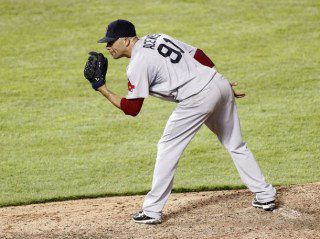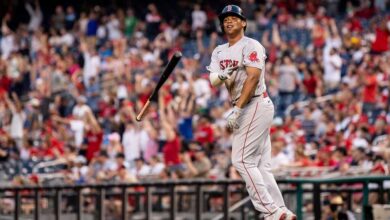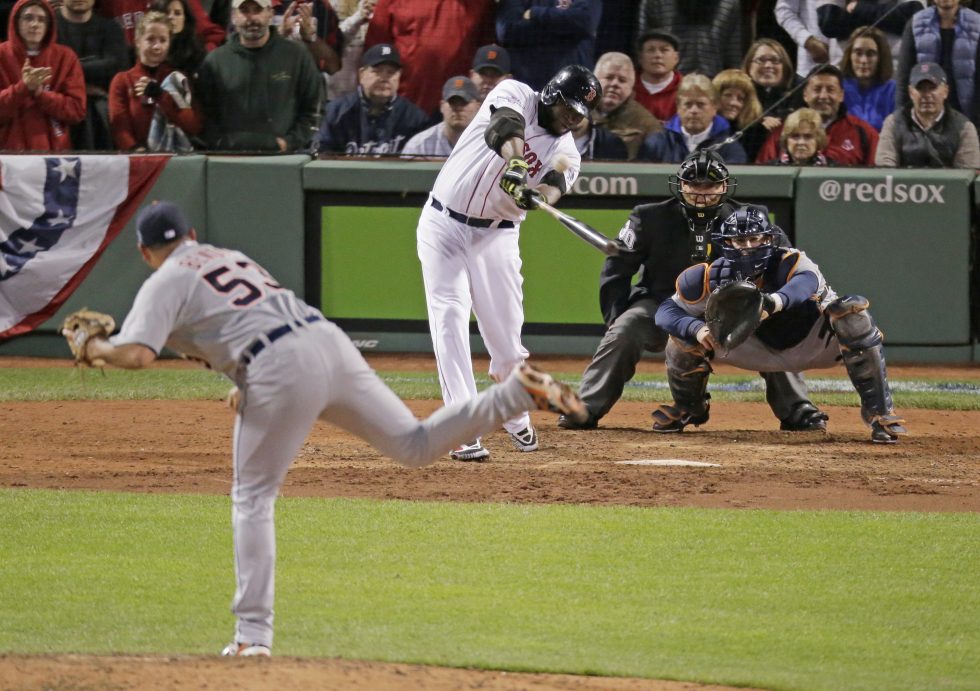

Tomorrow is Thanksgiving, and what better way to kick off the long weekend than by talking about a group of guys who know a good bird to eat when they see one: the Boston Red Sox starting rotation.
With the Red Sox seemingly on the brink of announcing a new manager, the hot stove is poised to be lighted, and, without question, the most important area for the Red Sox to improve upon is the starting rotation. I would argue that the Red Sox have not had a solid rotation since 2004, but, with their offense, those shortcomings have been overlooked.
Boston’s rotation is akin to the playing card analogy in “My Cousin Vinny”: “The D.A.’s got to build a case. Building a case is like building a house … He’s going to show you the bricks. He’ll show you they got straight sides. He’ll show you how they got the right shape. He’ll show them to you in a very special way, so that they appear to have everything a brick should have. But there’s one thing he’s not gonna show you. When you look at the bricks from the right angle, they’re as thin as this playing card. His whole case is an illusion, a magic trick. It has to be an illusion, ’cause you’re innocent.” As much as Bill and Stan are innocent in the movie, the Red Sox rotation was inconsistent coming into 2011. To compete with the elite American League teams, this will have to be rectified in 2012, so let’s carve up the current Sox battery and dig into what they have to do this offseason.
Jon Lester: Boston has had some impressive “Big Three’s” in their athletic history, but the trio of Lester, John Lackey, and Josh Beckett is not one of them, at least not in the way Boston fans would like them to be. Obviously, one issue that came out post-collapse was the clubhouse antics of this group, among others. Lester is in a unique position where, not only was he the first to come forward and speak about these allegations, but he was also the hero of game four of the 2007 World Series and has never had his character or his work ethic, particularly as a survivor of Non-Hodgkin’s Lymphoma, called into question. Growing up, my dad used to tell me (and I’m paraphrasing), “if you always do the right thing, it makes it easier for you to get away with something you do wrong.” With this, Lester seems to have received the benefit of the doubt from Boston fans who seem ready to “forgive and forget” for a guy who, ultimately, wins games. Lester is a competitor, and the humiliation of 2011 is something that is hopefully fueling his offseason work so that he may return to the hill for the opener in Detroit.
John Lackey: Lackey is an example of a player who fans might not be so forgiving of. In a season where Lackey was predicted to find his stride with the Red Sox, he set career lows with a 6.41 ERA and 119 runs allowed, while averaging 5.2 innings a start. Of those 119 runs, only five were unearned. Among other off-the-field issues, Lackey will be undergoing Tommy John surgery and is projected to miss the 2012 season.
Clay Buchholz: After a poorly diagnosed stress fracture in his lower back kept him out of the rotation from Memorial Day on, Buchholz will look to reclaim the dominant success he had in 2010 when he posted 17 wins and was a serious consideration for the Cy Young.
Josh Beckett: I would argue that Beckett has had two quality seasons with Boston: 2007 and 2009. His first season, 2006, and his injury-hindered 2010 season were invariably his worst, which leaves 2008 and 2011. The former was solid, but in September 2008, the Sox trailed Tampa in the AL East by two games with a six-game, home-and-home series over the course of the month. Beckett had a start in each series and lost both. Granted, one was a one-run game, and I will not fault him for that, but he also lost his starts between these series with opportunities to gain ground. The same can be said for 2011. Once it seemed that he would not win the Cy Young, Beckett gave up when the team was relying on him to be a stopper in the rotation and a leader in the dugout. Instead, he, among others, was in the clubhouse. The Boston Globe also reported that the same behavior existed when he was with Florida in 2003 during the first five games of the NLCS, when it seemed Chicago would win the pennant. The strength of the Boston rotation in 2012 depends on which Beckett we see: Beckett in the first five months of 2011, or Beckett in September 2011. The only difference is mentality.
Daisuke Matsuzaka: Much to the relief of Red Sox fans, Daisuke will be out for the 2012 season recovering from Tommy John surgery.
With Lackey and Dice-K out in 2012, the Red Sox have two spots open in the rotation, the only question is will they be filled from within or from free agency?
The fan-favorite at the moment was surprise offseason-pickup Alfredo Aceves. In 2011, Aceves was undoubtedly Boston’s 10th-man, filling every role a pitcher can fill over the course of the season. This success has prompted many, including David Ortiz, to call for Aceves to be inserted into the starting rotation, particularly during the September skid. However, in my mind, Aceves is not the answer for the Sox. What hurt the Sox most in September, and in the bottom of the rotation, was the inability of starters to go deep in games. When pitchers were upwards of 100 pitches in the fifth inning (see Lackey), who was there to clean up the mess and eat innings? Aceves, who posted a 10-2 record in 2011 while only starting four games. One of those two losses even came during one of these four starts. With his inability to go deep in games, but the ability to give quality innings consistently, Aceves is too valuable in the bullpen, and the Red Sox need to focus on bringing in pitchers who, win or lose, can get to the seventh inning and take the pressure off of the bullpen on a day-to-day basis.
A pitcher who fits this bill, and my top priority for the Red Sox this offseason, is Mark Buehrle. Buehrle’s numbers have always been a bit high for an ace pitcher, but not unreasonably so, and he has consistently put up only 13 wins in each of his last three seasons. His high-water mark came in 2002 when he posted 19 wins and, then again, with 16 wins on the way to a World Series title in 2005. Regardless, the number I am most concerned with is 205: Buehrle’s innings-pitched in 2011. Beckett pitched 193 innings this season and Lackey only pitched 160; an average of 5.2 innings per start. Cy Young winners Justin Verlander and Clayton Kershaw pitched 251 and 233, respectively. Buehrle’s 205 is actually low for him, and, as compared to Lackey, that extra forty innings is forty innings of rest for the bullpen.
At the fifth spot in the rotation, the Sox may be able to look internally. I have always supported Felix Doubront as a potential closer, but I imagine his future is most likely as a starter. Injuries have hindered his development in the last three seasons, but if he can get through spring training healthy, Doubront could be a strong fifth option for the Red Sox.
I mentioned in my article regarding the bullpen that strength in the starting rotation will directly impact the strength of the bullpen, namely because of the amount of starter-quality pitchers who could emerge as relievers. These would include the likes of Andrew Miller and Tim Wakefield. Miller, along with August-pickup Erik Bedard, was simply brought in to be a role player as a sixth starter and spot starter for injuries. Eventually, injuries thrust Miller into the regular fifth spot. He did not dominate in this role, but what fans lose sight of is the fact he wasn’t supposed to. He was called upon to be a role player, and he filled that role. When he was asked to do more, that is when he struggled. Out of the bullpen, Miller could provide strong middle relief in tandem with Matt Albers. Hopefully, Boston’s new skipper will recognize the value of left-handed relievers as more than just left-handed specialists; something former manager Terry Francona always overlooked.
Wakefield wants to come back, and I say let him. He has value as a mop-up man and spot starter, and to mix him in amongst hard-throwing starters and relievers, Wakefield, when he is on, can be fun to watch. Hopefully, he won’t have to be the regular-rotation man he had to be in parts of 2011.
I would be remiss if I did not mention Japanese product Yu Darvish. Though he is a hot topic right now, I think to go after Darvish at this point would be too much of a liability for the untested Ben Cherington. Had Daisuke been Theo Epstein’s coup de grace, fans would have run Theo out of town years ago. However, his signature move was the blockbuster Nomar Garciaparra-deadline deal in 2004 which eventually lead to the first Red Sox championship in 86 years, which will forever overshadow the Daisuke deal. Theo had some bad moves, such as J.D. Drew and Julio Lugo, but his ability to bring in championship components was unquestionable. Cherington does not yet have that base and to put the unnecessary pressure of bringing in an unproven, transplanted superstar could result in crippling fallout. Cherington’s charge is not to bring in superstars, they too easily fail. Rather, the focus for the Red Sox in 2012 is proven stability from whoever can provide it.





